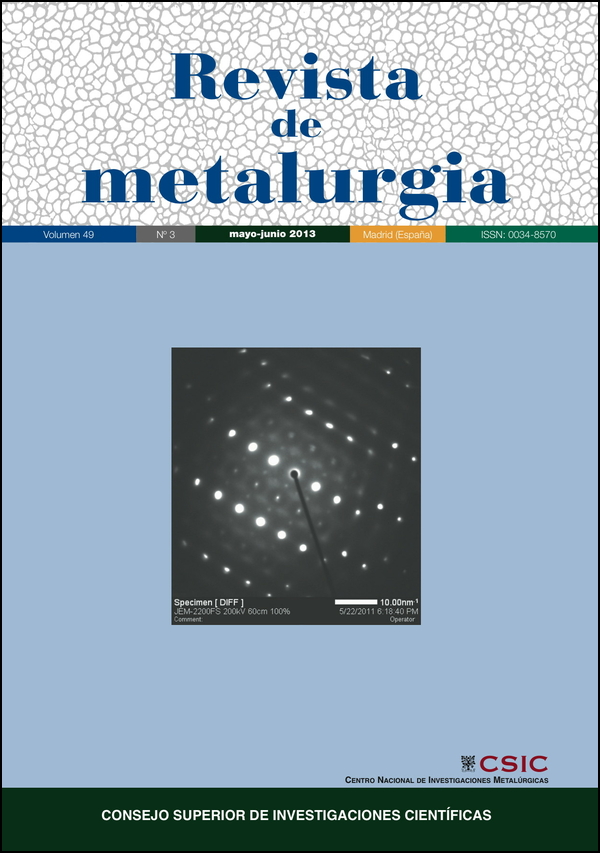Investigations on the influence of the shape factor and friction in compression processes of cylindrical billets of AA 6082-T6 aluminum alloy by numerical and experimental techniques
DOI:
https://doi.org/10.3989/revmetalm.1242Keywords:
Shape factor, Friction, Forging, FEM, CompressionAbstract
The material characterization under similar load conditions to those applied during manufacturing is important in order to analyse Bulk Forming Compression Processes from a more realistic point of view. Open die forging of AA 6082-T6 aluminum alloy has been analysed by using experimental techniques and Finite Elements Method (FEM). The influence of the workpiece geometry on the effects that friction produces in typical process variables such as applied forces, contact pressures and stresses and strains in workpieces has been analysed by FEM simulation. It has been shown that higher shape factors of the initial workpiece geometry are recommended in such a way that friction effect is minimised. These results are interesting in order to decrease the required energy of the process and the tool wear, and could be used in further analysis of stamping processes.
Downloads
References
[1] DIN 8582: 2003, Manufacturing processes forming-Classification, subdivision, terms and definitions, alphabetical index, Berlín, Germany, 2003.
[2] DIN 8585-3: 2003, Manufacturing processes forming under compressive conditions - Part 3: Free forming; Classification, subdivision, terms and definitions, Berlín, Germany, 2003
[3] T. Altan, G. Ngaile y G. Shen, ASM International, Columbus, OH, EE.UU., 2005.
[4] M.M. Marín, Tesis Doctoral, Universidad Nacional de Educación a Distancia (UNED), Madrid, Espa-a, 2011.
[5] S. Diot, D. Guines, A. Gavrus y E. Ragneau, J. Eng. Mater. Technol. 131 (2009) 1-10. http://dx.doi.org/10.1115/1.3026543
[6] R. Ebrahimi y A. Najafizadeh, J. Mater. Process. Tech.152 (2004) 136-143. http://dx.doi.org/10.1016/j.jmatprotec.2004.03.029
[7] D. Szeliga, J. Gawad y M. Pietrzyk, Comput. Method. Appl. 195 (2006) 6.778-6.798.
[8] H. Sofuoglu y H. Gedikli, Tribol. Int. 35 (2002) 27-34. http://dx.doi.org/10.1016/S0301-679X(01)00076-7
[9] X. Tan, Tribol. Int. 35 (2002) 385-393. http://dx.doi.org/10.1016/S0301-679X(02)00020-8
[10] J.P. Wang, J. Mater. Process. Tech. 123 (2002) 323-328. http://dx.doi.org/10.1016/S0924-0136(02)00015-8
[11] E.M. Rubio, R. Domingo, C. González y A. Sanz, Rev. Metal. 40 (2004) 90-100. http://dx.doi.org/10.3989/revmetalm.2004.v40.i1.242
[12] F. Fereshteh-Saniee, I. Pillinger y P. Hartley, J. Mater. Process. Tech. 153-154 (2004) 151- 156. http://dx.doi.org/10.1016/j.jmatprotec.2004.04.217
[13] A.M. Camacho, M.M. Marín, L. Sevilla y C. Bernal, Proc. ICADME, Taiyuan, China, 2012.
[14] M.M. Marín, A.M. Camacho, E.M. Rubio y M.A. Sebastián, Proc. ESM, C. Bertelle y A. AyeshGreen (Eds), EUROSIS, Ostende, Bélgica, 2008, pp. 51-55.
[15] A.M. Camacho, C. Vallellano, F.J. García- Lomas y M.A. Sebastián, Steel Res. Int. 81 (2010) 958-961.
[16] F. Fereshteh-Saniee y F. Fatehi-Sichani, J. Mater. Process. Tech. 177 (2006) 478-482. http://dx.doi.org/10.1016/j.jmatprotec.2006.04.043
[17] P. F. Bariani, T. Dal Negro y S. Bruschi, CIRP Annals - Manuf. Techn. 53 (2004) 573-595. http://dx.doi.org/10.1016/S0007-8506(07)60030-4
[18] A. Duckham y R. D. Knutsen, Mat. Sci. Eng. A-Struct. 256 (1998) 220-226. http://dx.doi.org/10.1016/S0921-5093(98)00811-9
[19] T. Altan, S.I. Oh y H.L. Gegel, ASM International, Columbus, OH, EE.UU., 1983. [20] D. Hibbitt, B. Karlsson y P. Sorensen, ABAQUS v6.10, User’s Manuals, Simulia, Providence, RI, EE.UU., 2010.
[21] R. Kopp y H. Wiegels, Einführung in die umformtechnick, Institut für Bildsame Formgebung, Ed. Mainz, G., Aachen, Germany, 1999.
[22] J.M. Arenas, M.A. Sebastián, P. Nú-ez y C. González, Rev. Metal. 36 (2000) 366-374. http://dx.doi.org/10.3989/revmetalm.2000.v36.i5.587
Downloads
Published
How to Cite
Issue
Section
License
Copyright (c) 2013 Consejo Superior de Investigaciones Científicas (CSIC)

This work is licensed under a Creative Commons Attribution 4.0 International License.
© CSIC. Manuscripts published in both the printed and online versions of this Journal are the property of Consejo Superior de Investigaciones Científicas, and quoting this source is a requirement for any partial or full reproduction.
All contents of this electronic edition, except where otherwise noted, are distributed under a “Creative Commons Attribution 4.0 International” (CC BY 4.0) License. You may read the basic information and the legal text of the license. The indication of the CC BY 4.0 License must be expressly stated in this way when necessary.
Self-archiving in repositories, personal webpages or similar, of any version other than the published by the Editor, is not allowed.
















